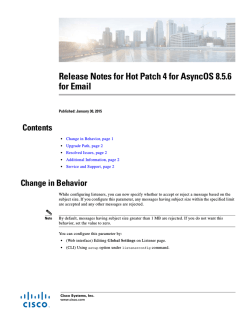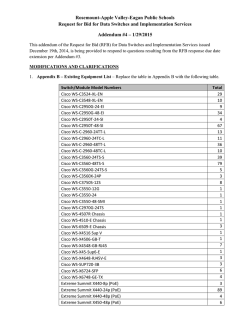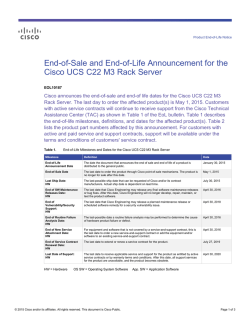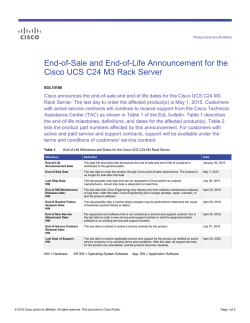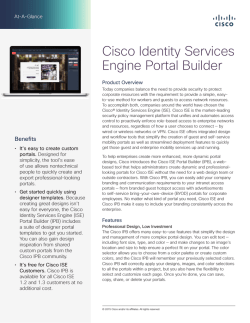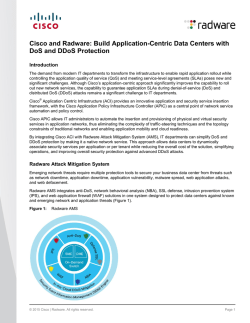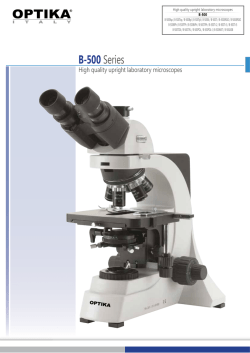
Release Notes for the Cisco IE 3000 Switch, Cisco IOS Release
Release Notes for the Cisco IE 3000 Switch,
Cisco IOS Release 15.2(1)EY
January 2014
Cisco IOS Release 15.2(1)EY runs on all Cisco Industrial Ethernet IE 3000, IE 2000, and IE 3010 switches.
Cisco IOS Software Release 15.2(1)EY is part of the new software releases on Cisco IE 3000, 2000,3010
Series Switches. These releases deliver new software and hardware innovations in Industrial deployments
that span across many technologies, including support for Cisco Resilient Ethernet protocol (REP),
IEEE1588v2 Precision Timing Protocol (PTP), Common Industrial Protocol ( CIP) and Profinet V2
These release notes include important information about Cisco IOS Release 15.2(1)EY, and any
limitations, restrictions, and caveats that apply to this release. Verify that these release notes are correct
for your switch:
•
If you are installing a new switch, see the Cisco IOS release label on the rear panel of your switch.
•
If your switch is on, use the show version privileged EXEC command. See the “Finding the
Software Version and Feature Set” section on page 5.
•
If you are upgrading to a new release, see the software upgrade filename for the software version.
See the “Deciding Which Files to Use” section on page 5.
You can download the switch software from this site (registered Cisco.com users with a login password):
http://www.cisco.com/cisco/software/navigator.html?a=ahttp://www.cisco.com/cisco/web/download/in
dex.htmli=rpm
Contents
•
System Requirements, page 2
•
System Requirements, page 2
•
Upgrading the Switch Software, page 4
•
Installation Notes, page 7
•
Software Features, page 8
•
Limitations and Restrictions, page 9
Americas Headquarters:
Cisco Systems, Inc., 170 West Tasman Drive, San Jose, CA 95134-1706 USA
© 2014 Cisco Systems, Inc. All rights reserved.
System Requirements
•
Important Notes, page 12
•
Open Caveats, page 13
•
Caveats Resolved in This Release, page 14
•
Related Documentation, page 15
•
Obtaining Documentation, Obtaining Support, and Security Guidelines, page 15
System Requirements
•
Supported Hardware, page 2
•
Express Setup Requirements, page 3
•
Cluster Compatibility, page 4
•
CNA Compatibility, page 4
Supported Hardware
Switches and Modules
.
Table 1
Cisco IE 3000 Switches and Modules
Supported by Minimum/Suggested Cisco IOS Release
Switch Model
Description
Cisco IE-3000-4TC
4 10/100BASE-T Ethernet ports and 2 dual-purpose ports,
each with a 10/100/1000BASE-T copper port and an SFP
(small form-factor pluggable) module slot
Minimum: Cisco IOS Release
12.2(55)SE;
Suggested: Cisco IOS Release
15.0(2)EY3 for PoE and SFP
expansion modules.
Cisco IE-3000-8TC
8 10/100BASE-T Ethernet ports and 2 dual-purpose ports
Minimum: Cisco IOS Release
12.2(55)SE;
Suggested: Cisco IOS Release
15.0(2)EY3 for PoE and SFP
expansion modules.
Cisco IE-3000-4TC-E
4 10/100BASE-T Ethernet ports and 2 dual-purpose ports
(supports the IP services software feature set)
Minimum: Cisco IOS Release
12.2(55)SE;
Suggested: Cisco IOS Release
15.0(2)EY3 for PoE and SFP
expansion modules.
Cisco IE-3000-8TC-E
8 10/100BASE-T Ethernet ports and 2 dual-purpose ports
(supports the IP services software feature set)
Minimum: Cisco IOS Release
12.2(55)SE;
Suggested: Cisco IOS Release
15.0(2)EY3 for PoE and SFP
expansion modules.
Cisco IEM-3000-8TM
Expansion module with 8 10/100BASE-T copper Ethernet
ports
Minimum: Cisco IOS Release
12.2(55)SE2
Release Notes for the Cisco IE 3000 Switch, Cisco IOS Release 15.2(1)EY
2
78-21410-01
System Requirements
Table 1
Cisco IE 3000 Switches and Modules
Switch Model
Description
Supported by Minimum/Suggested Cisco IOS Release
Cisco IEM-3000-8FM
Expansion module with 8 100BASE-FX fiber-optic
Ethernet ports
Minimum: Cisco IOS Release
12.2(55)SE2
Cisco IEM-3000-4SM1
Expansion module with 4 100BASE-FX fiber-optic
Ethernet ports
Cisco IOS Release 15.0(2)EY3
Note
The base switch supports up to two expansion
modules with various combinations including the
IEM-3000-8FM, IEM-3000-8TM and the
PoE/PoE+ modules IEM-3000-4PC and
IEM-3000-4PC-4TC. An exception to the
combination is that if you install an 8-port
IEM-3000-8FM or IEM-3000-8SM right after the
base switch, then you can install only one expansion
module.
Cisco IEM-3000-8SM1
Expansion module with 8 100BASE-FX fiber-optic
Ethernet ports
Cisco IOS Release 15.0(2)EY3
Cisco IEM-3000-4PC
Expansion module with 4 PoE 10/100BASE-T Ethernet
ports
Cisco IOS Release 15.0(2)EY3
Note
Each Power over Ethernet (PoE) or Power over
Ethernet Plus (PoE+) module requires an external
power supply besides the existing power supply
used to power up the base unit. A 44–57 V DC
power output is required to support PoE ports (15.4
W) and a 50–57 V DC power output is required to
support PoE+ ports (30 W) to meet the IEEE 802.3at
standard. Cisco power modules
PWR-IE65W-PC-AC (for AC input) and
PWR-IE65-PC-DC (for DC input) provide the 54 V
DC/1.2 A output to the PoE/PoE+ ports.
Cisco IEM-3000-4PC-4TC Expansion module with 4 PoE and 4 non-PoE
10/100BASE-T copper Ethernet ports
Cisco IOS Release 15.0(2)EY3
1. Does not support DOM SFP
Express Setup Requirements
Hardware
•
1 gigahertz (GHz) or faster 32-bit (x86) or 64-bit (x64) processor
•
1 gigabyte (GB) RAM (32-bit) or 2 GB RAM (64-bit)
•
16 GB available hard disk space (32-bit) or 20 GB (64-bit)
•
PC with Windows 7, or Mac OS 10.6.x
Software
Release Notes for the Cisco IE 3000 Switch, Cisco IOS Release 15.2(1)EY
78-21410-01
3
Upgrading the Switch Software
•
Web browser (Internet Explorer 9.0, 10.0, and 11.0, or Firefox 25, 26) with JavaScript enabled
•
Straight-through or crossover Category 5 or 6 cable
Express Setup verifies the browser version when starting a session, and it does not require a plug-in.
Cluster Compatibility
You cannot create and manage switch clusters through Device Manager. To create and manage switch
clusters, use the command-line interface (CLI) or the Network Assistant application.
When creating a switch cluster or adding a switch to a cluster, follow these guidelines:
•
When you create a switch cluster, we recommend configuring the highest-end switch in your cluster
as the command switch.
•
If you are managing the cluster through Network Assistant, the switch with the latest software
should be the command switch.
•
The standby command switch must be the same type as the command switch. For example, if the
command switch is a Cisco IE 3000 switch, all standby command switches must be Cisco IE 3000
switches.
For additional information about clustering, see Getting Started with Cisco Network Assistant and
Release Notes for Cisco Network Assistant (not orderable but available on Cisco.com), the software
configuration guide, and the command reference.
CNA Compatibility
Cisco IOS Release 15.2(1)EY is compatible with Cisco Network Assistant (CNA) 5.4 and later.
Note
CNA 5.4 and earlier do not support the cisco-ie-macros that were introduced in Cisco IOS Release
12.2(55)SE. Using the new Smartport role names will cause CNA errors.
Cisco recommends installing the latest version of CNA from this URL:
http://software.cisco.com/download/release.html?mdfid=280771500&softwareid=280775097&release
=5.8.6&flowid=5128
For more information about Cisco Network Assistant, see the Release Notes for Cisco Network Assistant
on Cisco.com.
Upgrading the Switch Software
•
Finding the Software Version and Feature Set, page 5
•
Deciding Which Files to Use, page 5
•
Archiving Software Images, page 5
•
Upgrading a Switch by Using Device Manager or Network Assistant, page 6
•
Upgrading a Switch by Using the CLI, page 6
•
Recovering from a Software Failure, page 7
Release Notes for the Cisco IE 3000 Switch, Cisco IOS Release 15.2(1)EY
4
78-21410-01
Upgrading the Switch Software
Finding the Software Version and Feature Set
The Cisco IOS image is stored as a bin file in a directory that is named with the Cisco IOS release. A
subdirectory contains the files needed for web management. The image is stored on the compact flash
memory card.
You can use the show version privileged EXEC command to see the software version that is running on
your switch. The second line of the display shows the version.
You can also use the dir filesystem: privileged EXEC command to see the directory names of other
software images that you might have stored in flash memory.
Deciding Which Files to Use
The upgrade procedures in these release notes describe how to perform the upgrade by using a combined
tar file. This file contains the Cisco IOS image file and the files needed for the embedded Device
Manager. You must use the combined tar file to upgrade the switch through Device Manager. To upgrade
the switch through the command-line interface (CLI), use the tar file and the archive download-sw
privileged EXEC command.
Table 2 lists the filenames for this software release.
If you download the IP services image and plan to use Layer 3 functionality, you must use the Switch
Database Management (SDM) routing template. To see which template is currently active template,
enter the show sdm prefer privileged EXEC command. If necessary, change the SDM template to the
routing template by entering the sdm prefer routing global configuration command. You will be
prompted to reload the switch to activate the new template.
Note
Table 2
The switch must be running Cisco IOS Release 12.2(52)SE or later to configure the routing template.
Cisco IOS Software Image Files
Filename
Description
"ies-lanbasek9-mz.152-1.EY.bin
Cisco IE 3000 cryptographic image file and Device Manager files with Layer
2+, Kerberos, and SSH features.
"ies-lanbasek9-tar.152-1.EY.tar
"ies-ipservicesk9-mz.152-1.EY.bin
"ies-ipservicesk9-tar.152-1.EY.tar
Cisco IE 3000 IP services cryptographic image and Device Manager files with
Kerberos, SSH, Layer 2+, and full Layer 3 features.
Archiving Software Images
As a best practice for any upgrade, you should first archive copies of the current Cisco IOS release and
the new Cisco IOS release before you upgrade to new software. You should keep these archived images
until you have upgraded all devices in the network to the new Cisco IOS image and until you have
verified that the new Cisco IOS image works properly in your network.
Cisco routinely removes old Cisco IOS versions from Cisco.com. See Product Bulletin 2863 for more
information:
http://www.cisco.com/en/US/prod/collateral/iosswrel/ps8802/ps6969/ps1835/prod_bulletin0900aecd80
281c0e.html
Release Notes for the Cisco IE 3000 Switch, Cisco IOS Release 15.2(1)EY
78-21410-01
5
Upgrading the Switch Software
You can copy the bin software image file on the flash memory to the appropriate TFTP directory on a
host by using the copy flash: tftp: privileged EXEC command.
Note
Although you can copy any file on the flash memory to the TFTP server, it is time consuming to copy
all of the HTML files in the tar file. We recommend that you download the tar file from Cisco.com and
archive it on an internal host in your network.
You can also configure the switch as a TFTP server to copy files from one switch to another without
using an external TFTP server by using the tftp-server global configuration command. For more
information about the tftp-server command, see the “Basic File Transfer Services Commands” section
of the Cisco IOS Configuration Fundamentals Command Reference, Release 12.2:
http://www.cisco.com/en/US/docs/ios/fundamentals/command/reference/cf_t1.html
Upgrading a Switch by Using Device Manager or Network Assistant
You can upgrade switch software by using Device Manager or Network Assistant. For detailed
instructions, click Help.
Note
When using Device Manager to upgrade your switch, do not use or close your browser session after the
upgrade process begins. Wait until after the upgrade process completes.
Upgrading a Switch by Using the CLI
This procedure is for copying the combined tar file to the switch. You copy the file to the switch from a
TFTP server and extract the files. You can download an image file and replace or keep the current image.
Note
Make sure that the compact flash card is inserted into the switch before downloading the software.
To download software, follow these steps:
Step 1
Use Table 2 on page 5 to identify the file that you want to download.
Step 2
Download the software image file:
a.
If you are a registered customer, go to this URL and log in.
http://software.cisco.com/download/navigator.html?mdfid=282082952&catid=268438038
b.
Navigate to Switches > Industrial Ethernet Switches.
c.
Navigate to your switch model.
d.
Click IOS Software, then select the latest IOS release.
e.
Download the image you identified in Step 1.
Step 3
Copy the image to the appropriate TFTP directory on the workstation, and make sure that the TFTP
server is properly configured.
For more information, see the Cisco IE 3000 Switch Software Configuration Guide.
Step 4
Log into the switch through the console port or a Telnet session.
Release Notes for the Cisco IE 3000 Switch, Cisco IOS Release 15.2(1)EY
6
78-21410-01
Installation Notes
Step 5
(Optional) Ensure that you have IP connectivity to the TFTP server by entering this privileged EXEC
command:
Switch# ping tftp-server-address
For more information about assigning an IP address and default gateway to the switch, see the software
configuration guide for this release.
Step 6
Download the image file from the TFTP server to the switch. If you are installing the same version of
software that is currently on the switch, overwrite the current image by entering this privileged EXEC
command:
Switch# archive download-sw /overwrite /reload
tftp:[[//location]/directory]/image-name.tar
The /overwrite option overwrites the software image in flash memory with the downloaded one.
The /reload option reloads the system after downloading the image unless the configuration has been
changed and not saved.
For //location, specify the IP address of the TFTP server.
For /directory/image-name.tar, specify the directory (optional) and the image to download. Directory
and image names are case sensitive.
This example shows how to download an image from a TFTP server at 198.30.20.19 and to overwrite
the image on the switch:
Switch# archive download-sw /overwrite tftp://198.30.20.19/image-name.tar
You can also download the image file from the TFTP server to the switch and keep the current image by
replacing the /overwrite option with the /leave-old-sw option.
Recovering from a Software Failure
For recovery procedures, see the “Troubleshooting” chapter in the software configuration guide for
this release.
Installation Notes
You can assign IP information to your switch by using these methods:
•
The Express Setup program, as described in the switch getting started guide.
•
The CLI-based setup program, as described in the switch hardware installation guide.
•
The DHCP-based autoconfiguration, as described in the switch software configuration guide.
•
Manually assigning an IP address, as described in the switch software configuration guide.
Release Notes for the Cisco IE 3000 Switch, Cisco IOS Release 15.2(1)EY
78-21410-01
7
Software Features
Software Features
Digital Optical Monitoring
Digital Optical Monitoring (DOM) is supported when using a DOM-capable SFP transceiver module.
For information about the switch models that have SFP or dual-purpose ports, see Switch Models
Supported, page 3. For information about DOM-capable SFP modules, see SFP Modules Supported,
page 6.
DOM allows monitoring real-time parameters of the router, such as optical input and output power,
temperature, laser bias current, and transceiver supply voltage. These parameters are monitored against
the threshold values. The real-time DOM parameters can be monitored using command line interface or
SNMP interface.
DOM is possible only with DOM-capable transeiver modules. When using an SFP module in a dual
purpose port, DOM is supported if the interface media type is configured to SFP or if global transceiver
monitoring is enabled.
Transceiver monitoring is enabled by default.
To view status information for the transceivers, enter these commands:
•
show interfaces transceiver
•
show interfaces transceiver detail
•
show interfaces transceiver threshold-table
•
show controllers gigabitethernet slot /port
For information about these commands, see Cisco IOS Master Commands List, All Releases at
www.cisco.com/en/US/docs/ios/mcl/allreleasemcl/all_book.html
Precison Time Protocol (PTP)
Several enhancements were made to improve the implementation of Precision time Protocol (PTP).
•
End-to-End Transparent Clock (E2E TC) now supports at least 300 PTP messages per second. The
previous capacity was 10 - 20 PTP messages per second. The E2E TC timing performance also was
enhanced to frequency lock to the GMC, thereby reducing timing errors.
•
With the recommended settings, the Boundary Clock now supports eight clocks in a chain
(previously became unstable with four clocks). The timing performance also was enhanced to
improve stability and precision. Cisco recommends setting the logDelReqInterval to -2 and the
logSyncInterval to -1 for chains of Boundary Clocks. The PTP Clock must receive 50 Sync messages
and 6 DelReq messages for a port to leave the UNCALIBRATED state.
•
Added support for PTP management messages, such as example: CLOCK_DESCRIPTION, as
defined in Clause 15 of IEEE Std 1588-2008. These management messages are mandatory for
CIP/ODVA compliance.
Release Notes for the Cisco IE 3000 Switch, Cisco IOS Release 15.2(1)EY
8
78-21410-01
Limitations and Restrictions
Security Group Tag Exchange Protocol for Cisco TrustSec
Cisco Industrial Ethernet switches now can participate in the Cisco TrustSec security architecture by
using the SGT Exchange Protocol (SXP). Cisco TrustSec establishes domains of trusted network
devices. After a device is authenticated, communication is secured by using encryption and other
mechanisms. As packets enter the network, they are classified by security group tags (SGTs) for the
purpose of applying security policies. SXP is used to propagate the SGTs across network devices, such
as the IE switches, that do not have hardware support for Cisco TrustSec.
To use this feature, enable SXP and configure the connections on each device that needs to participate
in SXP exchanges.
•
Enable SXP by entering the cts sxp enable command in global configuration mode.
•
Configure each SXP connection by specifying the peer’s IP address, the password, and the role. For
role, you can specify which device is the “speaker” and the “listener” in the exchange.
For detailed information about the configuration commands and show commands, see “SGT Exchange
Protocol over TCP (SXP)” at
http://www.cisco.com/en/US/partner/docs/switches/lan/trustsec/configuration/guide/sxp_config.html#
wp1056896
Note
The optional vrf parameter is supported only on IE3000 Series switches.
Limitations and Restrictions
You should review this section before you begin working with the switch. These are known limitations
that will not be fixed, and there is not always a workaround. Some features might not work as
documented, and some features could be affected by recent changes to the switch hardware or software.
This section contains these limitations:
•
Cisco IOS Limitations, page 9
•
Important Notes, page 12
Cisco IOS Limitations
•
Ethernet
•
IP
•
QoS
•
RADIUS
•
SPAN and RSPAN
•
Spanning Tree Protocol
•
Trunking
•
VLAN
Release Notes for the Cisco IE 3000 Switch, Cisco IOS Release 15.2(1)EY
78-21410-01
9
Limitations and Restrictions
Ethernet
•
Traffic on EtherChannel ports is not perfectly load-balanced. Egress traffic on EtherChannel ports
are distributed to member ports on load balance configuration and traffic characteristics like MAC
or IP address. More than one traffic stream may map to same member ports based on hashing results
calculated by the ASIC.
If this happens, uneven traffic distribution will happen on EtherChannel ports.
Changing the load balance distribution method or changing the number of ports in the EtherChannel
can resolve this problem. Use any of these workarounds to improve EtherChannel load balancing:
– for random source-ip and dest-ip traffic, configure load balance method as src-dst-ip
– for incrementing source-ip traffic, configure load balance method as src-ip
– for incrementing dest-ip traffic, configure load balance method as dst-ip
– Configure the number of ports in the EtherChannel so that the number is equal to a power of 2
(i.e. 2, 4, or 8)
For example, with load balance configured as dst-ip with 150 distinct incrementing destination IP
addresses, and the number of ports in the EtherChannel set to either 2, 4, or 8, load distribution is
optimal.(CSCeh81991)
IP
•
When the rate of received DHCP requests exceeds 2,000 packets per minute for a long time, the
response time might be slow when you are using the console.
The workaround is to use rate limiting on DHCP traffic to prevent a denial of service attack from
occurring. (CSCeb59166)
QoS
•
Some switch queues are disabled if the buffer size or threshold level is set too low with the mls qos
queue-set output global configuration command. The ratio of buffer size to threshold level should
be greater than 10 to avoid disabling the queue.
The workaround is to choose compatible buffer sizes and threshold levels. (CSCea76893)
•
When auto-QoS is enabled on the switch, priority queuing is not enabled. Instead, the switch uses
shaped round robin (SRR) as the queuing mechanism. The auto-QoS feature is designed on each
platform based on the feature set and hardware limitations, and the queuing mechanism supported
on each platform might be different. There is no workaround. (CSCee22591)
•
RADIUS change of authorization (COA) reauthorization is not supported on the critical auth
VLAN.
RADIUS
There is no workaround. (CSCta05071)
Release Notes for the Cisco IE 3000 Switch, Cisco IOS Release 15.2(1)EY
10
78-21410-01
Limitations and Restrictions
SPAN and RSPAN
•
When the RSPAN feature is configured on a switch, Cisco Discovery Protocol (CDP) packets
received from the RSPAN source ports are tagged with the RSPAN VLAN ID and forwarded to trunk
ports carrying the RSPAN VLAN. When this happens a switch that is more than one hop away
incorrectly lists the switch that is connected to the RSPAN source port as a CDP neighbor.
This is a hardware limitation. The workaround is to disable CDP on all interfaces carrying the
RSPAN VLAN on the device connected to the switch. (CSCeb32326)
•
CDP, VLAN Trunking Protocol (VTP), and Port Aggregation Protocol (PAgP) packets received
from a SPAN source are not sent to the destination interfaces of a local SPAN session. The
workaround is to use the monitor session session_number destination {interface interface-id
encapsulation replicate} global configuration command for local SPAN. (CSCed24036)
Spanning Tree Protocol
•
CSCtl60247
When a switch or switch stack running Multiple Spanning Tree (MST) is connected to a switch
running Rapid Spanning Tree Protocol (RSTP), the MST switch acts as the root bridge and runs
per-VLAN spanning tree (PVST) simulation mode on boundary ports connected to the RST switch.
If the allowed VLAN on all trunk ports connecting these switches is changed to a VLAN other than
VLAN 1 and the root port of the RSTP switch is shut down and then enabled, the boundary ports
connected to the root port move immediately to the forward state without going through the PVST+
slow transition.
There is no workaround.
Trunking
•
IP traffic with IP options set is sometimes leaked on a trunk port. For example, a trunk port is a
member of an IP multicast group in VLAN X but is not a member in VLAN Y. If VLAN Y is the
output interface for the multicast route entry assigned to the multicast group and an interface in
VLAN Y belongs to the same multicast group, the IP-option traffic received on an input VLAN
interface other than one in VLAN Y is sent on the trunk port in VLAN Y because the trunk port is
forwarding in VLAN Y, even though the port has no group membership in VLAN Y.
There is no workaround. (CSCdz42909).
•
For trunk ports or access ports configured with IEEE 802.1Q tagging, inconsistent statistics might
appear in the show interfaces counters privileged EXEC command output. Valid IEEE 802.1Q
frames of 64 to 66 bytes are correctly forwarded even though the port LED blinks amber, and the
frames are not counted on the interface statistics.
There is no workaround. (CSCec35100).
VLAN
•
If the number of VLANs times the number of trunk ports exceeds the recommended limit of 13,000,
the switch can fail.
The workaround is to reduce the number of VLANs or trunks. (CSCeb31087)
•
When line rate traffic is passing through a dynamic port, and you enter the switchport access vlan
dynamic interface configuration command for a range of ports, the VLANs might not be assigned
correctly. One or more VLANs with a null ID appears in the MAC address table instead.
Release Notes for the Cisco IE 3000 Switch, Cisco IOS Release 15.2(1)EY
78-21410-01
11
Limitations and Restrictions
The workaround is to enter the switchport access vlan dynamic interface configuration command
separately on each port. (CSCsi26392)
•
When many VLANs are configured on the switch, high CPU utilization occurs when many links are
flapping at the same time.
The workaround is to remove unnecessary VLANs to reduce CPU utilization when many links are
flapping. (CSCtl04815)
Important Notes
•
Device Manager Notes, page 12
•
SDM Template Notes, page 13
Device Manager Notes
•
You cannot create and manage switch clusters through Device Manager. To create and manage
switch clusters, use the CLI or Cisco Network Assistant.
•
We recommend this browser setting to speed up the time needed to display Device Manager from
Microsoft Internet Explorer.
From Microsoft Internet Explorer:
•
1.
Choose Tools > Internet Options.
2.
Click Settings in the “Temporary Internet files” area.
3.
From the Settings window, choose Automatically.
4.
Click OK.
5.
Click OK to exit the Internet Options window.
The HTTP server interface must be enabled to display Device Manager. By default, the HTTP server
is enabled on the switch. Use the show running-config privileged EXEC command to see if the
HTTP server is enabled or disabled.
Beginning in privileged EXEC mode, follow these steps to configure the HTTP server interface:
Command
Purpose
Step 1
configure terminal
Enter global configuration mode.
Step 2
ip http authentication {aaa | enable |
local}
Configure the HTTP server interface for the type of authentication that
you want to use.
•
aaa—Enable the authentication, authorization, and accounting feature.
You must enter the aaa new-model interface configuration command
for the aaa keyword to appear.
•
enable—Enable password, which is the default method of HTTP
server user authentication, is used.
•
local—Local user database, as defined on the Cisco router or access
server, is used.
Step 3
end
Return to privileged EXEC mode.
Step 4
show running-config
Verify your entries.
Release Notes for the Cisco IE 3000 Switch, Cisco IOS Release 15.2(1)EY
12
78-21410-01
Open Caveats
•
Device Manager uses the HTTP protocol (the default is port 80) and the default method of
authentication (the enable password) to communicate with the switch through any of its Ethernet
ports and to allow switch management from a standard web browser.
If you change the HTTP port, you must include the new port number when you enter the IP address
in the browser Location or Address field (for example, http://10.1.126.45:184 where 184 is the new
HTTP port number). You should write down the port number through which you are connected. Use
care when changing the switch IP information.
If you are not using the default method of authentication (the enable password), you need to
configure the HTTP server interface with the method of authentication used on the switch.
Beginning in privileged EXEC mode, follow these steps to configure the HTTP server interface:
Command
Purpose
Step 1
configure terminal
Enter global configuration mode.
Step 2
ip http authentication {enable | local |
tacacs}
Configure the HTTP server interface for the type of authentication that
you want to use.
•
enable—Enable password, which is the default method of HTTP
server user authentication, is used.
•
local—Local user database, as defined on the Cisco router or access
server, is used.
•
tacacs—TACACS server is used.
Step 3
end
Return to privileged EXEC mode.
Step 4
show running-config
Verify your entries.
SDM Template Notes
Due to changes in the default image settings, IP routing is no longer enabled in the default SDM
template. Systems that upgrade from an earlier Cisco IOS release to Release 15.2(1)EY must run a
non-default SDM template to preserve the earlier IP routing configurations.
Open Caveats
Note
You can click the issue number to view more information in the Cisco Bug Search tool (login required).
Issue
Description
CSCum65206
HQOS, Vlan-based qos and QOS maping to multiple interfaces was disabled in
15.2(1)EY.
Work Around: There is no workaround.
CSCuh36550
When power inline wattage max value is configured at the global
configuration level. The switch will print the error messages during boot up if
value is not the default value (65 watts)
Work Around: There is no operational impact and there is no workaround
Release Notes for the Cisco IE 3000 Switch, Cisco IOS Release 15.2(1)EY
78-21410-01
13
Caveats Resolved in This Release
Issue
Description
CSCtx35101
The password must be entered twice before it is accepted in Express Setup.
Work Around: There is no workaround.
CSCum76147
No warning for Port Security Settings changes displayed via Device Mgr.
Work Around: There is no workaround.
CSCum67722
Maximum mac address range should vary according to the SDM template
settings on the Eiskaffee. Maximum unicast mac address range is not similar to
CLI. In Eiskaffee for all the SDM template its shows as 8192 as maximum mac
range, which is incorrect.
Work Around: There is no workaround.
CSCum76505
Eiskaffee-S4P3-channel number beyond the limit not working as expected
Work Around: There is no workaround.
Caveats Resolved in This Release
Note
You can click the issue number to view more information in the Cisco Bug Search tool (login required).
Issue
Descripton
CSCui48101
When the power mode on a PoE interface is set to static, the port may go to
err-disable if sufficient power is not available.
Work Around: Use the default auto mode by entering the power inline auto
command.
CSCee32792
When using SNMP v3, the switch unexpectedly reloads when it encounters the
snmp_free_variable_element.
Work Around: There is no workaround:
CSCth59458
If a redundant power supply (RPS) switchover occurs during a bulk
configuration synchronization, some of the line configurations might disappear.
Work Around: The workaround is to reapply the line configurations.
CSCtl12389
The show ip dhcp pool command displays a large number of leased addresses.
Work Around: Turn off ip dhcp remember and reload the switch.
CSCtq64716
The following warning messages might be displayed during the boot process
even when a RADIUS or a TACACS server have been defined:
%RADIUS-4-NOSERVNAME:
or
%AAAA-4-NOSERVER: Warning: Server TACACS2 is not defined
Work Around: There is no work around.
CSCul58877
Hostnames can only support up to 16 characters.
Work Around: There is no work around.
Release Notes for the Cisco IE 3000 Switch, Cisco IOS Release 15.2(1)EY
14
78-21410-01
Related Documentation
Related Documentation
Installation, Configuration, Maintenance, and Operation Guides
http://www.cisco.com/en/US/products/ps9703/tsd_products_support_series_home.html
Online Help (available on the switch)
•
Express Setup online help
•
Device Manager online help
SFP Information
•
Compatibility Information:
www.cisco.com/en/US/products/hw/modules/ps5455/products_device_support_tables_list.html
•
Installation Notes:
www.cisco.com/en/US/products/hw/modules/ps5455/prod_installation_guides_list.html
MIBs
•
MIBs for this product are listed in the datasheet:
www.cisco.com/en/US/prod/collateral/switches/ps9876/ps12451/data_sheet_c78-705523.html
•
MIBs can be located with this MIB tool by using the IOS version number:
tools.cisco.com/ITDIT/MIBS/
Obtaining Documentation, Obtaining Support, and Security
Guidelines
For information on obtaining documentation, submitting a service request, and gathering additional
information, see the monthly What’s New in Cisco Product Documentation, which also lists all new and
revised Cisco technical documentation:
http://www.cisco.com/en/US/docs/general/whatsnew/whatsnew.html
Subscribe to the What’s New in Cisco Product Documentation as a Really Simple Syndication (RSS) feed
and set content to be delivered directly to your desktop using a reader application. The RSS feeds are a free
service and Cisco currently supports RSS version 2.0.
This document is to be used in conjunction with the documents listed in the “Related Documentation” section.
Cisco and the Cisco logo are trademarks or registered trademarks of Cisco and/or its affiliates in the U.S. and other countries. To view a list of
Cisco trademarks, go to this URL: www.cisco.com/go/trademarks. Third-party trademarks mentioned are the property of their respective owners. The
use of the word partner does not imply a partnership relationship between Cisco and any other company. (1110R)
© 2013 Cisco Systems, Inc. All rights reserved.
Release Notes for the Cisco IE 3000 Switch, Cisco IOS Release 15.2(1)EY
78-21410-01
15
Obtaining Documentation, Obtaining Support, and Security Guidelines
Release Notes for the Cisco IE 3000 Switch, Cisco IOS Release 15.2(1)EY
16
78-21410-01
© Copyright 2025
